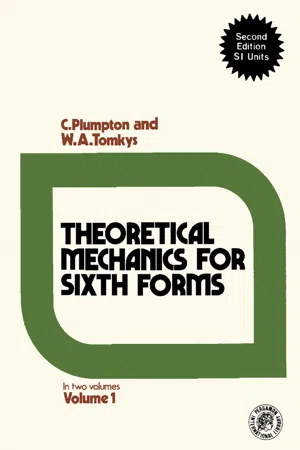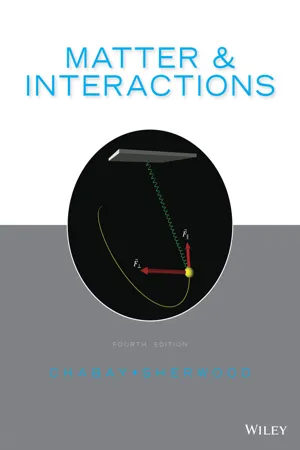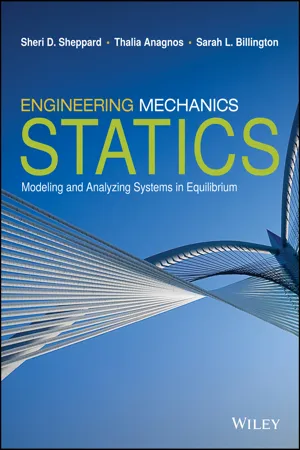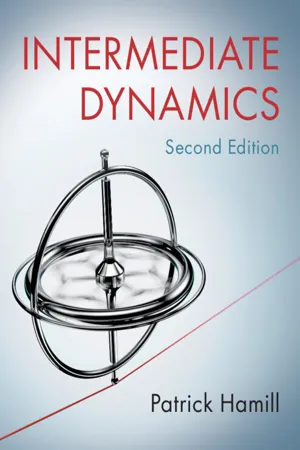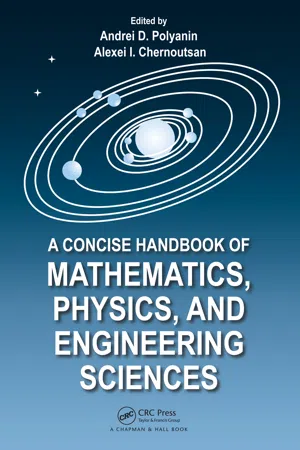Physics
Moment Physics
In physics, a moment refers to the turning effect produced by a force around a pivot point. It is calculated by multiplying the force by the perpendicular distance from the pivot point. Moments are crucial in understanding rotational motion and equilibrium of objects. They are used to analyze the stability and balance of structures and machines.
Written by Perlego with AI-assistance
Related key terms
1 of 5
7 Key excerpts on "Moment Physics"
- eBook - PDF
Theoretical Mechanics for Sixth Forms
In Two Volumes
- C. Plumpton, W. A. Tomkys(Authors)
- 2016(Publication Date)
- Pergamon(Publisher)
If, however, the mass of weight W were moved nearer to G, equilibrium would be broken by the rod turning in a clock-wise direction about G. This tendency of a force to turn a rigid body about an axis is called the turning effect of the force. Experiment shows that, when the rod in this example is in equilibrium, Wxdx = W 2 d 2 . The product Wd is defined as the moment of the force W about G and it is the measure of the turning effect of W± about G. Thus, the Moment of a Force about a point is the product of the force and the perpendicular distance of the point from the line of action of the force. The moment of a force about a line (i.e. about an axis) is defined as the product of the resolved part of the force at right angles to the given line and the shortest distance between the line of action of the force and the given line. In this book we consider systems of coplanar forces only, so that a reference to moment about a point is equivalent to a reference to moment about an axis through that point perpendicular to the plane of the forces. The moment of a force about a point is a directed quantity which can either be counterclockwise (positive in this book) or clock-wise (negative in this book). If a rigid body is in equilibrium under the action of a number of coplanar parallel forces, the sum of the moments of the forces about any point in their plane is zero. This is the Law of the Lever. 132 THEORETICAL MECHANICS Units Since the moment of a force about a point is the product of force and distance, the unit of Moment is the new ton-metre (Nm). This unit is dimensionally equivalent to the unit of work (see Chapter VITI); it is called the joule (J). In § 6.2 the relation between the Law of the Lever and the Parallelo-gram of Forces is considered. Example 1. A thin uniform rod AB of length 2 m and mass 10 kg is supported horizontally at its centre of gravity G and masses of 5 kg, 8 kg are attached to the rod at P, Q respectively, where AP = 0-6 m, AQ = 1-3 m. - eBook - PDF
- Ruth W. Chabay, Bruce A. Sherwood(Authors)
- 2015(Publication Date)
- Wiley(Publisher)
By modeling the system as an extended object, we see that the force by the Earth on a child or on the unevenly balanced board exerts a twist (the technical term is “torque”) about the pivot that tends to make the board turn. Torque has a magnitude and a direction, so it can be expressed as a vector. In order for the rate of rotation to be zero (or any other constant) the torques associated with the forces on the two children and the board must add up to 184 Chapter 5 Determining Forces from Motion zero. Torque is defined as force times lever arm, and a nonzero net torque causes changes in a quantity called angular momentum, just as a nonzero net force causes changes in the ordinary momentum we have been studying. The Angular Momentum Principle quantitatively relates the net torque on a system to the rate of change of the system’s rotation. In the present chapter we will continue to consider most objects (except things like wires, vines, and springs, which can stretch or compress) as point particles, which cannot deform or rotate. 5.5 CHANGING MOMENTUM In the preceding sections we focused on systems whose momentum is constant. In such situations we know immediately that the value of d p/dt is zero, and that therefore the net force must also be zero. In this section we deal with systems consisting of several objects, in which the momentum may be changing. The motion of the center of mass is determined by the net force acting on the system, but we may want to know the forces that objects inside the system exert on each other. Consider the following example, which is typical of a class of problems called “dynamics” problems, in which it is often necessary to analyze different choices of system in order to determine some unknown forces, based on the motion. If you are studying engineering you may take an entire course on “dynamics.” load 2 (m 2 ) F load 1 (m 1 ) cable (m 3 ) (tug) Figure 5.17 A space tug pulls two loads connected by a steel cable. - eBook - PDF
Engineering Mechanics: Statics
Modeling and Analyzing Systems in Equilibrium
- Sheri D. Sheppard, Thalia Anagnos, Sarah L. Billington(Authors)
- 2017(Publication Date)
- Wiley(Publisher)
By pushing downward on the wrench, you are applying a moment* to the nut. This moment is created by the force exerted by your hand on the wrench and is about the axis of the bolt (which in the figure is perpendicular and “into” the page). The magnitude of the moment is the product of the magnitude of the applied force and the distance from the center of the bolt to your hand. The effects of an applied moment depend in part on where a force is applied to an object or system. Consider for example the can illustrated in Figure 3.1.2. If you place your hand near the bottom of the can and push, the can does not tip over. If you place your hand near the top of the can and push, the can turns over due to the moment you have applied. A moment is a load created by a force that is offset relative to a point in space. It is a vector quantity and therefore has both magnitude and direction. In working with moments, we are concerned with the force’s position relative to this point in space, the magnitude, direction, and sense of the moment, and its graphical depiction. Let’s look at these ele- ments one at a time. Moment Center The point from which the force is offset is the moment center (or MC for short). The moment center can be specified by x, y, and z coordinates in a Cartesian coordinate system. Position Vector A position vector is any vector that runs from the moment center to a point on the line of action of the force (Figure 3.1.3). Position vectors are commonly specified in vector notation (e.g., position vector r is specified as r x i + r y j + r z k, where r x , r y , and r z are scalar components in the i, j, and k directions, respectively, from the MC to the point on the line of action). 118 *Some physics textbooks use the word torque for what we are calling moment—namely, the tendency of a force to cause tipping or turning. As we will see in Chapter 9, engineers generally use the word torque to describe a moment created in conjunction with a machine. - eBook - PDF
- Patrick Hamill(Author)
- 2022(Publication Date)
- Cambridge University Press(Publisher)
(1.12) This relationship is valid even if the mass is not constant. In fact, it is the most general statement of Newton’s second law. The force F appearing in Newton’s second law is the net or total vector sum of all forces acting on the body. Consequently, we appreciate that if the net force is zero, the time derivative of the momentum is zero. That is, the momentum of the body is constant. This is called the law of conservation of momentum. Exercise 1.6 A 1500 kg car traveling East at 40 km/h turns a corner and speeds up to a velocity of 50 km/h due North. What is the change in the car’s momentum? Answer: 26 700 kg m/s at 38.7 ◦ West of North. 1.5 Rotational Motion 9 1.5 Rotational Motion 1.5.1 Rotational Kinematics The motion of a rigid body rotating about a fixed axis is mathematically identical to one- dimensional linear motion. Recall that kinematics is a study of the relationship between position, velocity, acceleration, and time. Rotational kinematics deals with angular position (θ ), angular velocity (ω), and angular acceleration (α), where angular velocity is defined by ω ≡ dθ dt , and angular acceleration is α ≡ dω dt = d 2 θ dt 2 . You will discover in Chapters 7, 16, and 17 that rotational motion can be very complicated. To keep things simple for the moment, consider the special case of a symmetrical body rotating about a fixed axis, such as the wheel illustrated on the left side of Figure 1.4. For a fixed, stationary axis, the center of the wheel is at rest. All other points are moving in circles around it. If you looked straight down the axis you would see the circle shown on the right side of Figure 1.4. Point P is on the rim of the wheel. The angular position of P is given by the angle between some fixed line and the radius vector to P . If the wheel is turning, after a time dt point P will have moved a distance ds to P . Recall from geometry that ds = rdθ , where dθ (in radians of course!) is the angle subtended by the arc P P = ds . - eBook - PDF
- John D. Cutnell, Kenneth W. Johnson, David Young, Shane Stadler(Authors)
- 2018(Publication Date)
- Wiley(Publisher)
DEFINITION OF ANGULAR MOMENTUM The angular momentum L of a body rotating about a fixed axis is the product of the body’s moment of inertia I and its angular velocity ω with respect to that axis: L = Iω (9.10) Requirement: ω must be expressed in rad/s. SI Unit of Angular Momentum: kg · m 2 /s Linear momentum is an important concept in physics because the total linear momentum of a system is conserved when the sum of the average external forces acting on the system is zero. Then, the final total linear momentum P f and the initial total linear momentum P 0 are the same: P f = P 0 . In the case of angular momentum, a similar line of reasoning indicates that when the sum of the average external torques is zero, the final and initial angular momenta are the same: L f = L 0 , which is the principle of conservation of angular momentum. PRINCIPLE OF CONSERVATION OF ANGULAR MOMENTUM The total angular momentum of a system remains constant (is conserved) if the net average external torque acting on the system is zero. Example 13 illustrates an interesting consequence of the conservation of angular momentum. (a) (b) FIGURE 9.23 (a) A skater spins slowly on one skate, with both arms and one leg outstretched. (b) As she pulls her arms and leg in toward the rotational axis, her angular velocity increases. CONCEPTUAL EXAMPLE 13 BIO The Physics of a Spinning Skater In Figure 9.23a an ice skater is spinning with both arms and a leg out- stretched. In Figure 9.23b she pulls her arms and leg inward. As a result of this maneuver, her angular velocity increases dramatically. Why? Neglect any air resistance and assume that friction between her skates and the ice is negligible. (a) A net external torque acts on the skater, causing to increase. (b) No net external torque acts on her; she is simply obeying the conservation of angular momentum. (c) Due to the movements of her arms and legs, a net internal torque acts on the skater, causing her angular momentum and to increase. - Andrei D. Polyanin, Alexei Chernoutsan(Authors)
- 2010(Publication Date)
- CRC Press(Publisher)
The angular momentum direction coincides with that of ω (determined by the right hand rule). The quantity I z = summationdisplay j m j R 2 j = integraldisplay R 2 dm (P1. 9 . 1 . 2 ) is called the moment of inertia of the body about the axis z . Differentiating (P1.9.1.1) with respect to time and taking into account that dL z /dt = M z , where M z is the moment of external forces about the axis of rotation (see equation (P1.6.3.2)), we get M z = I z ε , (P1. 9 . 1 . 3 ) 430 P HYSICAL F OUNDATIONS OF M ECHANICS where ε = dω/dt is the angular acceleration. This equation is referred to as the basic equation of rotational dynamics of a rigid body about a fixed axis . Compute also the kinetic energy of the rotating body, E k = summationdisplay j m j v 2 j 2 = 1 2 ω 2 summationdisplay j m j R 2 j = 1 2 I z ω 2 , (P1. 9 . 1 . 4 ) and the work done by an external force F on rotating the body, A = integraldisplay d r ⋅ F = integraldisplay ( ω dt × r ) ⋅ F = integraldisplay ( ω dt ) ⋅ ( r × F ) = integraldisplay M ⋅ d ϕ , where d ϕ = ω dt . Example. A body of mass m is attached to one end of a weightless rope wound around a pulley of radius R and moment of inertia I . Find the acceleration of the body after it has been released. Solution. Let us write Newton’s second law for the body: mg – T = ma . The equation of motion of the pulley (P1.9.1.3) is TR = Iε . Using the kinematic relation a = εR (the rope does not slide against the pulley) and solving the above equations for a , we obtain a = g/ ( 1 + I/mR 2 ). P1.9.2. Properties of Moment of Inertia The moment of inertia (P1.9.1.2) is a scalar quantity that characterizes the distribution mass of the body relative to the axis of rotation. It can be seen from equations (P1.9.1.3) and (P1.9.1.4) that the moment of inertia is a measure of the body’s inertia with respect to rotational motion; moment of inertia plays the same role as mass in translational motion.- Raymond Serway, John Jewett(Authors)
- 2018(Publication Date)
- Cengage Learning EMEA(Publisher)
Let’s see if a similar statement can be made for rotational motion. The total angular momen- tum of a system of particles about some axis is defined as the vector sum of the angular momenta of the individual particles: L S tot 5 L S 1 1 L S 2 1 Á 1 L S n 5 o i L S i where the vector sum is over all n particles in the system. Differentiating this equation with respect to time gives d L S tot dt 5 o i d L S i dt 5 o i t S i where we have used Equation 11.13 to replace the time rate of change of the angu- lar momentum of each particle with the net torque on the particle. The torques acting on the individual particles of the system are those associ- ated with internal forces between particles and those associated with external forces. The net torque associated with all internal forces, however, is zero. Recall that Newton’s third law tells us that internal forces between particles of the system occur in pairs that are equal in magnitude and opposite in direction. If we assume these forces lie along the line of separation of each pair of particles, the total torque around some axis passing through an origin O due to each action–reaction force pair is zero (that is, the moment arm d from O to the line of action of the forces is equal for both particles, and the forces are in opposite directions). In the summation, therefore, the net internal torque is zero. We conclude that the total angular momentum of a system can vary with time only if a net external torque is acting on the system: o t S ext 5 d L S tot dt (11.15) This equation is indeed the rotational analog of o F S ext 5 d p S tot y dt for a system of particles. Equation 11.15 is the mathematical representation of the angular momentum version of the nonisolated system model. If a system is nonisolated in the sense that there is a net external torque on it, the net external torque on the system is equal to the time rate of change of the angular momentum of the system.
Index pages curate the most relevant extracts from our library of academic textbooks. They’ve been created using an in-house natural language model (NLM), each adding context and meaning to key research topics.
